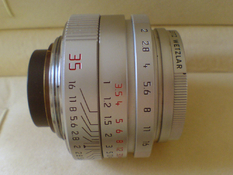As a mostly wide-angle photographer, the Leica-R 19mm Elmarit-R f2.8 and the Summicron-R 35/2 lenses are really stunning to the point of feeling excited about film photography all over again. The Leica-R Super Angulon 21/4 was designed by Schneider Kreuznach of Germany, whose optical advances in the ultra-wide angle field is second to none, particularly in large format photography. Its design is easier to use than the Contax C/Y 18/4 lens with its rather unusual front element filter although the lens suffers in most areas compared to the Contax C/Y 21/2.8 Distagon. In terms of semi-fisheyes, the Leica R 15mm f2.8 I've never tried however this is going to be the spectacular lens for denting the wallet. I use the Zeiss Distagon 16/2.8 which is better than a 3rd party wide angle lens ....
More brain-dump from my experience :
The 19mm f/2.8 II suffers from corner vignetting even at f/8. We had one on loan from Leica ( swap ) while at Oberkochen in 1998. From careful inspection it seemed to be from the internal filter-holder aperture. This is a great shame, because in all other respects this lens is great and a major step up from the Type I . It is a lens that was up to current MTF/contrast standards when released. If you don't shoot slide film then it's probably acceptable.
On the 35's, I've owned late-model versions of both the 35/2.8 and the 35/2. Though the f/2 was useful and nicely contrasty, I found the f/2.8 superior, mostly in sharpness in the field, and this is borne out also in tests we did at the time. I sold the 35/2 for twice the amount I had paid for it, recently ! Neither of these lenses is as good as the superb Zeiss ZE/ZF 35 f/2 that came out in the early 2000's . I also have a 35/1.4 early-90's which is being prepared for sale ( stupid money, cannot be retained ! ) . This was the best of its bunch at the time but stopped-down, the 35/2.8 is still slightly better in the field.
The Leica 21mm f/4 Super Angulon retrofocus was designed by Walter Woltche , who later worked at Oberkochen and designed the anniversary 55mm f/1.2 and 85mm f/1.2 lenses for Contax, amongst many other designs. He was a superb lens designer and a very amusing and generous man. The 21 was a great lens at the time, but suffers from lateral colour in the field and would be outclassed in sharpness by most modern lenses. I have also owned a copy of the 19mm Type 1, and this was bigger but similar in correction, quite a bit of colour off-axis, but it was pretty impressive at f/2.8 considering its vintage.
ps. I think the Leica 21/4 was better than the Zeiss 18/4 which really had a LOT of off-axis colour.
The Contax 21/2.8 by Schuster was a massive step up from these early designs and used many elements of anomalous-dispersion glass to cure secondary-lateral colour. It is the sharpest lens I ever tested using my own film-based tests with sector targets, back in the 90's. I also had the pleasure of using Schuster's PC-ApoDist 25mm f/3.5 which was even more over-the-top in construction and was critically sharp across the frame already at f/3.5. Don't spend any time on EBay searching for one of these - there is only one in Oberkochen, and one floating around somewhere in Japan, which belonged to Kyocera.
The Leica 15mm f/2.8 is not a semi-fisheye. It is a rectilinear wide angle, though it may have 3% distortion, this would be typical of lenses in this class.
Talking about Fisheye 16mm f/2.8's , I have just remembered that this was
also a Minolta design ( D'Oh ! ) that was built to better standards, with better coatings, by Leica. Silly me .







